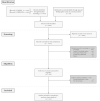Coronavirus disease (COVID-19) and the liver: a comprehensive systematic review and meta-analysis
- PMID: 32623633
- PMCID: PMC7335221
- DOI: 10.1007/s12072-020-10071-9
Coronavirus disease (COVID-19) and the liver: a comprehensive systematic review and meta-analysis
Abstract
Background: Liver function derangements have been reported in coronavirus disease (COVID-19), but reported rates are variable.
Methods: We searched PubMed and Embase with terms COVID and SARS-COV-2 from December 1, 2019 till April 5, 2020. We estimated overall prevalence, stratified prevalence based on severity, estimated risk ratio (RR), and estimated standardized mean difference (SMD) of liver function parameters in severe as compared to non-severe COVID. Random effect method utilizing inverse variance approach was used for pooling the data.
Results: In all, 128 studies were included. The most frequent abnormalities were hypoalbuminemia [61.27% (48.24-72.87)], elevations of gamma-glutamyl transferase (GGT) [27.94% (18.22-40.27)], alanine aminotransferase (ALT) [23.28% (19.92-27.01)], and aspartate aminotransferase (AST) [23.41% (18.84-28.70)]. Furthermore, the relative risk of these abnormalities was higher in the patients with severe COVID-19 when compared to non-severe disease [Hypoalbuminemia-2.65 (1.38-5.07); GGT-2.31 (1.6-3.33); ALT-1.76 (1.44-2.15); AST-2.30 (1.82-2.90)]. The SMD of hypoalbuminemia, GGT, ALT, and AST elevation in severe as compared to non-severe were - 1.05 (- 1.27 to - 0.83), 0.76 (0.40-1.12), 0.42 (0.27-0.56), and 0.69 (0.52-0.86), respectively. The pooled prevalence and RR of chronic liver disease as a comorbidity was 2.64% (1.73-4) and 1.69 (1.05-2.73) respectively.
Conclusion: The most frequent abnormality in liver functions was hypoalbuminemia followed by derangements in gamma-glutamyl transferase and aminotransferases, and these abnormalities were more frequent in severe disease. The systematic review was, however, limited by heterogeneity in definitions of severity and liver function derangements. Graphical depiction of the summary of meta-analytic findings a) pooled prevalence of abnormalities b) Risk ratio of abnormality in severe versus non-severe COVID-19 c) standardized mean difference (SMD) between severe and non-severe group and d) pooled prevalence for parameters based on severity stratification for bilirubin, alanine aminotransferase (ALT), aspartate aminotransferase (AST), alkaline phosphatase (ALP), gamma-glutamyl transferase (GGT), albumin, globulin and acute hepatic injury (AHI) . Also estimates for overall/total liver disease (TLD) and chronic liver disease (CLD) amongst COVID-19 patients are depicted in a, b, d. For d) In addition to severity stratification, Overall (all studies for a particular estimate) and combined (only those studies which reported severity) estimates are provided.
Keywords: COVID-19; Cirrhosis; Histology; SARS-CoV-2; Transplantation.
Conflict of interest statement
M. Praveen Kumar, Shubhra Mishra, Daya Krishna Jha, Jayendra Shukla, Arup Choudhury, Ritin Mohindra, Harshal S. Mandavdhare, Usha Dutta, and Vishal Sharma declare that they have no conflict of interest.
Figures






Similar articles
-
Incidence, risk factors, and prognosis of abnormal liver biochemical tests in COVID-19 patients: a systematic review and meta-analysis.Hepatol Int. 2020 Sep;14(5):621-637. doi: 10.1007/s12072-020-10074-6. Epub 2020 Jul 24. Hepatol Int. 2020. PMID: 32710250 Free PMC article.
-
Dynamic changes in liver function parameters in patients with coronavirus disease 2019: a multicentre, retrospective study.BMC Infect Dis. 2021 Aug 16;21(1):818. doi: 10.1186/s12879-021-06572-z. BMC Infect Dis. 2021. PMID: 34399709 Free PMC article.
-
SARS-CoV-2 infection of the liver directly contributes to hepatic impairment in patients with COVID-19.J Hepatol. 2020 Oct;73(4):807-816. doi: 10.1016/j.jhep.2020.05.002. Epub 2020 May 11. J Hepatol. 2020. PMID: 32437830 Free PMC article.
-
Pattern of liver injury in adult patients with COVID-19: a retrospective analysis of 105 patients.Mil Med Res. 2020 Jun 7;7(1):28. doi: 10.1186/s40779-020-00256-6. Mil Med Res. 2020. PMID: 32507110 Free PMC article.
-
Prevalence of liver injury and correlation with clinical outcomes in patients with COVID-19: systematic review with meta-analysis.Eur Rev Med Pharmacol Sci. 2020 Dec;24(24):13072-13088. doi: 10.26355/eurrev_202012_24215. Eur Rev Med Pharmacol Sci. 2020. PMID: 33378061
Cited by
-
COVID-19 and comorbidities of hepatic diseases in a global perspective.World J Gastroenterol. 2021 Apr 7;27(13):1296-1310. doi: 10.3748/wjg.v27.i13.1296. World J Gastroenterol. 2021. PMID: 33833483 Free PMC article. Review.
-
Digestive involvement in COVID-19: what we have learned in the past 12 months.Med Pharm Rep. 2021 Oct;94(4):395-401. doi: 10.15386/mpr-2061. Epub 2021 Oct 30. Med Pharm Rep. 2021. PMID: 36105494 Free PMC article. Review.
-
Impact of COVID-19 on the Gastrointestinal Tract: A Clinical Review.Cureus. 2022 Mar 20;14(3):e23333. doi: 10.7759/cureus.23333. eCollection 2022 Mar. Cureus. 2022. PMID: 35464519 Free PMC article. Review.
-
Characterization of Virus Replication, Pathogenesis, and Cytokine Responses in Syrian Hamsters Inoculated with SARS-CoV-2.J Inflamm Res. 2021 Aug 11;14:3781-3795. doi: 10.2147/JIR.S323026. eCollection 2021. J Inflamm Res. 2021. PMID: 34408462 Free PMC article.
-
COVID-19 and liver dysfunction: Epidemiology, association and potential mechanisms.Clin Res Hepatol Gastroenterol. 2022 Feb;46(2):101793. doi: 10.1016/j.clinre.2021.101793. Epub 2021 Aug 21. Clin Res Hepatol Gastroenterol. 2022. PMID: 34428501 Free PMC article. Review.
References
-
- World Health Organisation. Interim guidance: Clinical management of severe acute respiratory infection (SARI) when COVID-19 disease is suspected. 2nd Edition. WHO/2019-nCoV/clinical/2020.4
Publication types
MeSH terms
LinkOut - more resources
Full Text Sources
Medical
Miscellaneous

